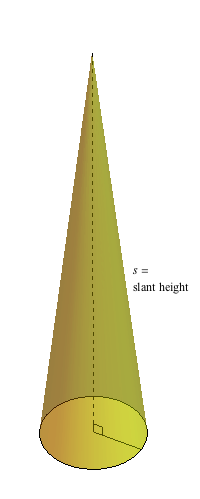Surface Area of a Cone = πr2 + πrs
To find the surface area of a cone, we need to find the area of the circular base and the area of the curved section. This one involves a new measurement, s, which is the length of the slanted part.

If you take apart the cone, you get two surfaces, the circular base, and the curved sides. The area of the base is just πr2, and the area of the curved section is πrs. So, the total surface area of a cone is πr2 +πrs.

Look Out: surface area is only two-dimensional and is expressed as units squared, not units cubed. This is because we are only dealing with the flat surfaces, not the inside space.
Example 1
| This cube has six congruent faces, each with a length and width of 3 cm. Area of one face = 3 x 3 cm = 9 cm2 Surface area = 6 sides x 9 cm2 = 54 cm2 |
Example 2
| This trapezoidal prism has six sides, two congruent trapezoids and four rectangles.
|
Example 3
| This cylinder has two circles (each with a radius of 2 cm) and one rectangle (with a length of 5.8 cm and a width the circumference of the circles).
|
Example 4
This pyramid is made up of four equilateral triangles.
| Here we just need to find the area of one triangle and multiply it by four sides: Area of 1 triangle = ½bh = ½(8 x 6.9) = 27.6 cm2 Now, multiply that by four sides, and we're done. 110.4 cm2 |
Example 5 - Sphere
| The diameter of this sphere is 11.9 cm, so the radius is half of that, 5.95 cm.
|
Example 6- Cone
| The area of the circular base is equal to:
|











